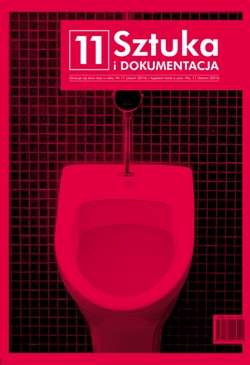Świat podzielony. Geopolityka sztuki według KwieKulik
The divided world. The geopolitics of art according to KwieKulik
Author(s): Tomasz ZałuskiSubject(s): Fine Arts / Performing Arts
Published by: Akademia Sztuk Pięknych w Gdańsku
Keywords: KwieKulik; żelazna kurtyna; geopolityka; sztuka; socjalizm; kapitalizm; podróże; performance; powtórzenie; iron curtain; geopolitics; art; socialism; capitalism; journeys; performance; repetition
Summary/Abstract: The aim of the article is to trace the impact of the geopolitical division between the West and the East - as symbolized by the iron curtain - on the biography, artistic theories and practices of Polish duo KwieKulik. I focus on the artists’ attempts to spread abroad information about Polish ephemeral art. I am particularly interested in their journeys to the West, during which they presented their performances and showed art documentation. KwieKulik were critically aware of the incommensurability of Western capitalist and Eastern socialist economic and political conditions of life and art production. What is more, they conceived their art as deeply embedded in those conditions and they used it as a means of exposing and commenting on them. In the divided world, there was no ‘universal’ realm, or the universal existed only in so far as it was also divided. According to KwieKulik, to expose the local conditions of life and art under socialism was the only chance to be universal. They were against the attempts on the part of some Polish neo-avantgarde artists to appropriate Western artistic idioms and try to symbolically enter the Western art world as, supposedly, its rightful participants. Such self-colonisation by subordinating oneself to the West as a substitute cultural hegemon seemed inauthentic to them and it led to art practices that were without any meaningful and critical relationship with the local socialist reality. At the end of the seventies and throughout the eighties KwieKulik confronted the divided reality while traveling to western countries and presenting their art. There they often repeated performances - linking them in new confi gurations called ‘multiperformances’ - that were originally showed in Poland. They did so because each time they came to the West, they had to present themselves as a ‘repeated debut’, as artists with no artistic biography and no symbolic capital - except for one connected with coming from the East. Thus, repeating performances could play the role of ‘performing the documentation’. Another thing was that KwieKulik were probably unable to prepare a premiere performance that would answer the specifi c nature of Western life and art. The Western conditions were simply not theirs and they had not shaped their existential and artistic experience.
Journal: Sztuka i Dokumentacja
- Issue Year: 2014
- Issue No: 11
- Page Range: 19-41
- Page Count: 23
- Language: Polish

